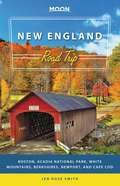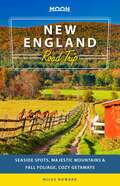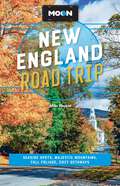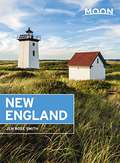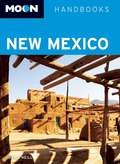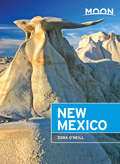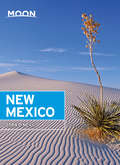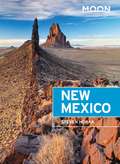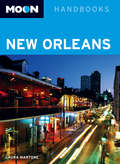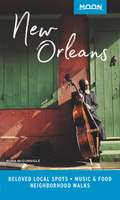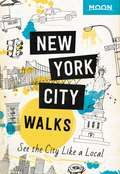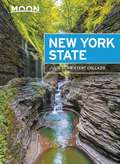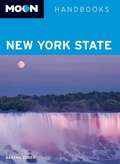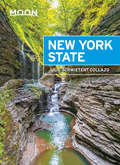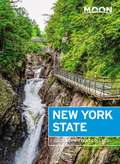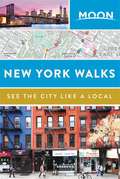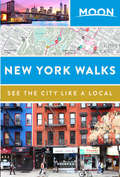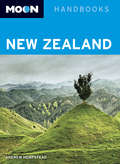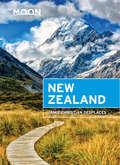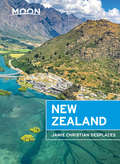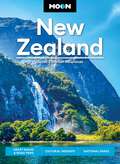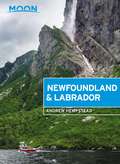- Table View
- List View
Moon New England Road Trip: Boston, Acadia National Park, White Mountains, Berkshires, Newport, and Cape Cod (Travel Guide)
by Jen Rose SmithHit the Road with Moon Travel Guides!Discover an America brimming with culture and history, both old and new! Moon New England Road Trip can do everything but change the radio station. Inside you'll find:Maps and Driving Tools: 70 easy-to-use maps keep you oriented on and off the highway, along with site-to-site mileage, driving times, and detailed directions for the entire routeEat, Sleep, Stop and Explore: You'll know exactly what you want to do at each stop with lists of the best hikes, views, and more. Sample farm-fresh cuisine in the Berkshires, or hit up the famous Tanglewood music festival in the summer. Dive into Boston's revolutionary history, or cruise down bucolic lanes of Woodstock. Take to the sea off the coast of Maine to spot humpback whales and puffin colonies, or lounge on the beach and snag a buttery lobster rollItineraries for Every Traveler: Drive the entire two-week route or follow strategic routes like "A Tour of the Fall Foliage," as well as suggestions for spending time in Boston, New York City, Coastal Maine, The Berkshires, Southern Vermont, New Hampshire's White Mountains, Newport, Cape Cod, and Acadia National ParkLocal Expert: Local New Englander and road warrior Jen Rose Smith shares the highway secrets of Maine, New Hampshire, Vermont, Massachusetts, New York, and Rhode IslandPlanning Your Trip: Know when and where to get gas, how to avoid traffic, tips for driving in different road and weather conditions, and suggestions for LGBTQ travelers, seniors, and road trippers with kidsWith Moon New England Road Trip's practical tips, detailed itineraries, and insider's view, you're ready to fill up the tank and hit the road.Looking to explore more of America on wheels? Try Moon Blue Ridge Parkway Road Trip! Doing more than driving through? Check out Moon Boston, Moon Vermont, or Moon New York State.
Moon New England Road Trip: Seaside Spots, Majestic Mountains & Fall Foliage, Cozy Getaways (Travel Guide)
by Miles HowardFrom the misty mountains in Maine to the coastal charms of Cape Cod, there's no shortage of adventure in New England: Get ready to hit the road with Moon New England Road Trip. Inside you'll find:Multiple Routes: Choose from flexible road trips like a fall foliage tour, getaways from the cities, or the ultimate two-week route through all of New EnglandEat, Sleep, Stop and Explore: With lists of the best hikes, views, eateries, and more, you can trek among spruce trees in the White Mountains, cycle through Acadia National Park, or cruise down bucolic lanes of Woodstock. Take to the sea and spot humpback whales and puffin colonies, shop for wood-fired maple syrup, or snag a buttery lobster roll after a day at the beach. Dive into Boston's revolutionary history, sample farm-fresh produce in the Berkshires, party in Providence, or sip your way through some of the area's best microbreweriesMaps and driving tools: Easy-to-use maps keep you oriented on and off the highway, along with site-to-site mileage, driving times, detailed directions, and full-color photos throughoutLocal Expertise: Lifelong New Englander and road warrior Miles Howard shares the local secrets of Maine, New Hampshire, Vermont, Massachusetts, New York, and Rhode IslandPlanning Your Trip: Know when and where to get gas, how to avoid traffic, tips for driving in different road and weather conditions, and suggestions for LGBTQ travelers, seniors, and road trippers with kidsWith Moon New England Road Trip's practical tips, detailed itineraries, and insider's view, you're ready to fill up the tank and hit the road.Looking to explore more of America on wheels? Try Moon Blue Ridge Parkway Road Trip! Spending more time in the city? Check out Moon Boston. About Moon Travel Guides: Moon was founded in 1973 to empower independent, active, and conscious travel. We prioritize local businesses, outdoor recreation, and traveling strategically and sustainably. Moon Travel Guides are written by local, expert authors with great stories to tell—and they can't wait to share their favorite places with you.For more inspiration, follow @moonguides on social media.
Moon New England Road Trip: Seaside Spots, Majestic Mountains, Fall Foliage, Cozy Getaways (Moon Road Trip Travel Guide)
by Moon Travel Guides Miles HowardFrom the misty mountains in Maine to the coastal charms of Cape Cod, there's no shortage of adventure in New England: Get ready to hit the road with Moon New England Road Trip. Inside you'll find:Multiple Routes: Choose from flexible road trips like a fall foliage tour, getaways from the cities, or the ultimate two-week route through all of New England Eat, Sleep, Stop and Explore: With lists of the best hikes, views, eateries, and more, you can trek among spruce trees in the White Mountains, cycle through Acadia National Park, or cruise down bucolic lanes of Woodstock. Take to the sea and spot humpback whales and puffin colonies, shop for wood-fired maple syrup, or snag a buttery lobster roll after a day at the beach. Dive into Boston's revolutionary history, sample farm-fresh produce in the Berkshires, party in Providence, or sip your way through some of the area's best microbreweries Maps and driving tools: Easy-to-use maps keep you oriented on and off the highway, along with site-to-site mileage, driving times, detailed directions, and full-color photos throughoutLocal Expertise: Lifelong New Englander and road warrior Miles Howard shares the local secrets of Maine, New Hampshire, Vermont, Massachusetts, New York, and Rhode Island Planning Your Trip: Know when and where to get gas, how to avoid traffic, tips for driving in different road and weather conditions, and suggestions for LGBTQ travelers, seniors, and road trippers with kids With Moon New England Road Trip's practical tips, detailed itineraries, and insider's view, you're ready to fill up the tank and hit the road. Looking to explore more of America on wheels? Try Moon Blue Ridge Parkway Road Trip! Spending more time in the city? Check out Moon 52 Things to Do in Boston.About Moon Travel Guides: Moon was founded in 1973 to empower independent, active, and conscious travel. We prioritize local businesses, outdoor recreation, and traveling strategically and sustainably. Moon Travel Guides are written by local, expert authors with great stories to tell—and they can't wait to share their favorite places with you. For more inspiration, follow @moonguides on social media.
Moon New England: Boston, Acadia National Park, White Mountains, Berkshires, Newport, And Cape Cod (Travel Guide)
by Jen Rose SmithExplore the best of New England's historic cities, admire the famed fall foliage, and stroll the stunning coastline with Moon New England. Inside you'll find:Flexible itineraries for every season, including quick weekend getaways from Boston and New York and two weeks exploring all of New EnglandStrategic advice for foliage-seekers, beach bums, winter sports enthusiasts, foodies, and moreCan't-miss highlights and unique experiences: Catch America's first sunrise at Acadia, or hike the rocky landscape of the White Mountain Peaks. Sample your way through craft breweries, or sip chowder in America's oldest restaurant. Explore rolling dunes and sandy beaches at Cape Cod, and find the best local seafood shack for lobster rolls, fresh-shucked oysters, and piles of fried clams. Follow in the footsteps of the founders on Boston's Freedom Trail, or gaze at glamorous 19th-century mansions in Newport. Hit the top slopes in the region for skiing and snowboarding, or watch the changing leaves paint the landscape in red and goldExpert advice from Vermont local Jen Rose Smith on when to go, where to stay, and how to get aroundFull-color photos and detailed regional and city maps throughoutThorough background on the wildlife, landscape, climate, and local cultureRecommendations for families with children, international visitors, seniors, travelers with disabilities, and moreFocused coverage of Boston, Cape Cod and the Islands, the Berkshires, Connecticut, Rhode Island, Vermont, New Hampshire's Seacoast and Lakes Region, New Hampshire's White Mountains, Coastal Maine, and Acadia National ParkWith Moon New England's practical tips and local know-how, you can plan your trip your way.Hitting the road? Try Moon New England Road Trip. Looking for more New England? Try Moon Boston or Moon Vermont.
Moon New Mexico
by Zora O'NeillNew Mexico native Zora O'Neill gives you her insider's perspective on New Mexico, from museum-hopping in Santa Fe to visiting organic farms. Zora includes a variety of unique trip ideas, including Nuclear New Mexico and 14-Day Grand Tour. Packed with information on dining, transportation, and accommodations, Moon New Mexico has lots of options for a range of travel budgets. Complete with details on Santa Fe, Taos, Albuquerque, and more, Moon New Mexico gives travelers the tools they need to create a more personal and memorable experience.
Moon New Mexico
by Zora O'NeillThis full-color guide to New Mexico includes vibrant photos and helpful planning maps.New Mexico native Zora O'Neill shares her insider's perspective on the Land of Enchantment, from museum-hopping in Santa Fe to exploring the vast beauty of the desert to visiting organic farms. Packed with information on dining, transportation, and accommodations, this guide offers different options for a range of travel budgets. Complete with details on Santa Fe, Taos, Albuquerque, and more, Moon New Mexico gives travelers the tools they need to create a more personal and memorable experience.
Moon New Mexico (Moon Handbooks Ser.)
by Zora O'NeillMoon Travel Guides: A New Way to Discover New Mexico From sandstone canyons and austere mesas, to snowcapped mountain peaks, discover an otherworldly landscape and unique culture with this guide to the Land of Enchantment. Moon New Mexico features: Curated trip advice for outdoor adventurers, culture mavens, history buffs, foodies, and moreFull-color, vibrant photos and detailed maps throughoutExpert insight with a local perspective from born-and-raised Santa Fe native Zora O'NeillStrategic itineraries for every budget and timeline-from a few days to three weeks-including: A Week in the Wild West, Not Just Hot Tamales, Black Stone, White Sands, Retro Route 66 and Beyond, Native New Mexico, Ancient and Modern, and Weird and WonderfulThe best drives through New Mexico, including Route 66, the Turquoise Trail, the Sunspot Highway, and a state-wide road tripHonest advice on where to stay, where to eat, and how to get aroundFocused coverage of Albuquerque, Sante Fe, Taos and North Central New Mexico, Las Vegas and the Northeast, Navajo Nation and the Northwest, Las Cruces and the Southwest, and Carlsbad Caverns and the SoutheastMust-see attractions and offbeat ideas: Wiggle through tiny tunnels on a dive into Carlsbad Caverns, or take a mountain biking tour of the badlands and white sand dunes. Wander a ghost town graveyard, visit the International UFO Museum in Roswell, or count the bullet holes in the ceilings of preserved 19th century saloons. Experience the Native American history and culture, including pueblo visits, ceremonial dances, and markets. Sample local cuisine, from Tucumcari cheese and Pecos beef to green-chile cheeseburgers, and explore the bustling nightlife, spirited art scene, and rich history of Santa FeAccurate, up-to-date information including background on the landscape, plants and animals, history, government, and local cultureHandy tools including a Spanish glossary, health and safety tips, and advice for families, seniors, international visitors, and LGBTQ+ travelersWith Moon New Mexico's myriad activities, practical advice, and local insight on the best things to do and see, you can plan your trip your way. If you're exploring New Mexico's major cities, Try Moon Santa Fe, Taos and Albuquerque. Hitting the road? Try Moon Southwest Road Trip. Crossing National Parks off your bucket list? Try Moon Grand Canyon.
Moon New Mexico (Travel Guide)
by Steven HorakFrom hiking sandstone canyons to chowing down on southwestern cuisine, fall under the spell of the Land of Enchantment with Moon New Mexico. Inside you'll find:Strategic, flexible itineraries with ideas for art lovers, outdoor adventurers, history buffs, and moreTop experiences and unique activities: Wander through a ghost-town graveyard, count the bullet holes in the ceilings of preserved 19th-century saloons, or visit the birthplace of the atomic bomb. Soar through New Mexico's clear blue sky on a colorful hot air balloon. Spark inspiration and delight in the spirited art scene of Santa Fe, or seek an extraterrestrial experience at the International UFO Museum & Research Center in RoswellSavor the flavors: Dig into traditional local cuisine, like red sauce-smothered enchiladas, tender carne adovada, and hearty posole. Indulge in juicy green-chile cheeseburgers or opt for something lighter from one of New Mexico's many organic farm-to-table restaurantsOutdoor adventures: Go deep on a trek into the mesmerizing underground world of Carlsbad Caverns or venture off-trail in the De-Na-Zin Wilderness to view stunning hoodoos. Raft from surging waters to gentle currents on the Rio Grande or explore the wavelike gypsum dunes of White Sands National MonumentWays to respectfully engage with native cultures: Attend a dance ceremony or a powwow, tour a pueblo, or peruse handmade goods at a marketLocal insight from Santa Fe dweller Steven Horak on when to go, where to stay, and how to get aroundFull-color, vibrant photos and detailed maps throughoutThorough background on the landscape, wildlife, climate, and local culture, plus advice for families, seniors, international visitors, and LGBTQ+ travelersFocused coverage of Albuquerque, Santa Fe, Taos, Navajo Nation, Las Cruces, Carlsbad, and moreWith Moon New Mexico's practical tips and local know-how, you can find your adventure.Exploring more of the Southwest? Try Moon Arizona & the Grand Canyon or Moon Zion & Bryce. Hitting the road? Try Moon Southwest Road Trip.
Moon New Mexico: Outdoor Adventures, Road Trips, Local Culture (Travel Guide)
by Steven HorakFrom hiking sandstone canyons to chowing down on southwestern cuisine, fall under the spell of the Land of Enchantment with Moon New Mexico. Inside you'll find:Strategic, flexible itineraries with ideas for art lovers, outdoor adventurers, history buffs, and more Top experiences and unique activities: Wander through a ghost-town graveyard, count the bullet holes in the ceilings of preserved 19th-century saloons, or visit the birthplace of the atomic bomb. Soar through New Mexico's clear blue sky on a colorful hot air balloon. Spark inspiration and delight in the spirited art scene of Santa Fe, or seek an extraterrestrial experience at the International UFO Museum & Research Center in Roswell Savor the flavors: Dig into traditional local cuisine, like red sauce-smothered enchiladas, tender carne adovada, and hearty posole. Indulge in juicy green-chile cheeseburgers or opt for something lighter from one of New Mexico's many organic farm-to-table restaurants Outdoor adventures: Go deep on a trek into the mesmerizing underground world of Carlsbad Caverns or venture off-trail in the De-Na-Zin Wilderness to view stunning hoodoos. Raft from surging waters to gentle currents on the Rio Grande or explore the wavelike gypsum dunes of White Sands National Park Ways to respectfully engage with indigenous cultures: Attend a dance ceremony or a powwow, tour a pueblo, or peruse handmade goods at a market Local insight from Santa Fe dweller Steven Horak Full-color, vibrant photos and detailed maps throughoutThorough background on the landscape, wildlife, health and safety, climate, and local culture, plus advice for families, seniors, international visitors, and LGBTQ+ travelers Focused coverage of Albuquerque, Santa Fe, Taos, Navajo Nation, Las Cruces, Carlsbad, and more Find your adventure with Moon New Mexico. Exploring more of the Southwest? Try Moon Arizona & the Grand Canyon or Moon Zion & Bryce. Hitting the road? Try Moon Southwest Road Trip. About Moon Travel Guides: Moon was founded in 1973 to empower independent, active, and conscious travel. We prioritize local businesses, outdoor recreation, and traveling strategically and sustainably. Moon Travel Guides are written by local, expert authors with great stories to tell—and they can't wait to share their favorite places with you. For more inspiration, follow @moonguides on social media.
Moon New Orleans
by Laura MartoneNew Orleans native Laura Martone offers an insider's take on her hometown, from shopping on Magazine Street to listening to old-time jazz in Faubourg Marigny. Martone also includes a handful of fun trip itinerary ideas, including A Romantic Weekend, Mardi Gras, and Haunted New Orleans. With information on taking carriage rides through the French Quarter, visiting the Art District's museums, and bicycling within City Park, Moon New Orleans gives travelers the tools they need to create a more personal and memorable experience.
Moon New Orleans: Beloved Local Spots, Music & Food, Neighborhood Walks (Travel Guide)
by Nora McGunnigleThe spicy scent of crawfish, the crooning of a corner saxophonist, the refreshing sip of an authentic Sazerac: New Orleans is a true sensory feast. Take a bite out of the Big Easy with Moon New Orleans. Explore the City: Navigate by neighborhood or by activity with color-coded maps, or follow a guided neighborhood walk through Uptown, the Warehouse District, Treme, and moreSee the Sites: Learn about African American history at the Backstreet Cultural Museum, ride the St. Charles Streetcar, and sip a little something while you shop on Magazine Street. Take a leisurely bike ride in City Park, appreciate the wild beauty of the bayou, and explore 300 years of history in the city's famous cemeteries. Get a Taste of the City: Enjoy funky eateries serving Asian-Southern fusion, vegan soul food, and modern Latin fare, or head uptown to the classic French-Creole restaurants and corner po-boy shops. Savor sweet beignets with cafe au lait, sample Cajun classics like alligator and boudin, and dive into a delicious bowl of gumboBars and Nightlife: Sip a Sazerac in the Roosevelt Hotel or a Ramos Gin Fizz straight from a shaker machine, listen to the live music on Frenchmen Street, discover the best gay bars in town, and take your cocktail to go. Sample stouts at a local microbrewery, see what's on draft at the first cidery in New Orleans, and find out where the locals go to laissez les bon temps roulerLocal Advice from proud New Orleanian Nora McGunnigleFlexible, Strategic Itineraries for music lovers, foodies, history buffs, and more, plus easy trips outside the city including Jungle Gardens, Bayou Teche Brewing, and the Blue Moon Saloon and GuesthouseTips for Travelers including where to stay, how to safely bike around the city, and advice for LGBTQ+ visitors, international travelers, families with children, and moreMaps and Tools like background information on the history and culture of New Orleans, easy-to-read maps, full-color photos, and neighborhood guidesGo beyond the French Quarter and experience the real New Orleans with Moon's practical tips and local know-how.Hitting the road? Try Moon Nashville to New Orleans Road Trip. If you're heading to more of the South's best cities, try Moon Nashville or Moon Charleston & Savannah.
Moon New York City (Travel Guide)
by Christopher KompanekFrom the corner bodega to the top of the Empire State Building, NYC is overflowing with energy and culture. Experience the city with a local with Moon New York City.Explore the City: Navigate by neighborhood or by activity with color-coded maps, or follow a self-guided neighborhood walkSee the Sights: Dive into culture at the Metropolitan Museum of Art, or stroll down sun-dappled paths in Central Park before dinner and a Broadway showGet a Taste of the City: From cutting-edge fine dining to a slice from a beloved pizzeria, New York has something for every palateBars and Nightlife: Jazz clubs, beer gardens, cocktail lounges, world-class theater, and parties that don't end before dawn: New York is truly the city that never sleepsTrusted Advice: Native New Yorker and journalist Christopher Kompanek shows you his hometownStrategic Itineraries: Make the most of your trip with ideas for foodies, culture-seekers, families traveling with kids, and moreFull-Color Photos and Detailed Maps so you can explore on your ownHandy Tools: Background information on history and culture, plus an easy-to-read foldout map to use on the goWith Moon New York City's practical tips and local know-how, you can plan your trip your way.Looking to experience more world-class cities? Try Moon Boston or Moon Chicago. Exploring the rest of the Empire State? Check out Moon New York State or Moon Niagara Falls.
Moon New York City Walks: See the City Like a Local (Travel Guide)
by Moon Travel GuidesExperience the city that never sleeps like a local: on foot! Whether you're strolling along tree-lined streets in the Village or hustling down Fifth Avenue, discover the best of the Big Apple with Moon New York City Walks.Walk through the city's coolest neighborhoods, including Soho, the West Village, the Lower East Side, Williamsburg, and more, with color-coded stops and turn-by-turn directionsFind your scene with top ten lists for restaurants, arts and culture, and coffeeGet to know the real New York on six customizable walks: Stroll past icons like the Flatiron Building, the Empire State Building, and Rockefeller Center, or learn more about the history of jazz and the Harlem Renaissance. Take in jaw-dropping views along the High Line, shop the trendiest brands in the Meatpacking District, and explore world-famous galleries and museums. Cross the Williamsburg Bridge, hit a flea market, and discover coffee shops tucked among the Brooklyn warehouses. Sample authentic Chinese noodles and dim sum, comforting soul food, and old-school deli standbys, or admire the city skyline from one of New York's many rooftop barsExplore on the go with foldout maps of each walking route and a removable full-city map, all in a handy guide that fits in your pocketDiscover public transportation options like bike rentals, subway, taxis, buses, and ferriesWith creative routes, public transit options, and a full-city map, you can explore New York at your own pace, without missing a beat.Check out our guides to more of the world's best cities, so you can hit the ground running! Also available: Moon Barcelona Walks, Moon Berlin Walks, Moon Tokyo Walks, Moon Amsterdam Walks, Moon Paris Walks, Moon Rome Walks, and Moon London Walks.
Moon New York State
by Julie Schwietert CollazoTraveler and author Julie Schwietert Collazo covers the best of New York State, from iconic metropolis New York City to rural, natural regions such as Madison County and the Finger Lakes. Schwietert Collazo provides a variety of unique travel strategies for any kind of traveler, such as The Best of New York State, Three Weekend Getaways, and Culture Outside New York City. Including expert advice on dining and entertainment in all five boroughs of New York City as well as richly historical sights in central New York, Moon New York State gives travelers the tools they need to create a more personal and memorable experience.
Moon New York State
by Sascha ZugerTraveler and author Sascha Zuger covers the best of New York State, from iconic metropolis New York City to rural, natural regions such as Madison County and the Finger Lakes. Zuger provides a variety of unique travel strategies for any kind of traveler, such as The Best of New York State, Three Weekend Getaways, and Culture Outside New York City. Including expert advice on dining and entertainment in all five boroughs of New York City as well as richly historical sights in central New York, Moon New York State gives travelers the tools they need to create a more personal and memorable experience.
Moon New York State (Travel Guide)
by Julie Schwietert CollazoMoon Travel Guides: A New Way to Discover New York State!Writer and New Yorker Julie Schweitert Collazo shares her tips on exploring the Empire State. From the iconic metropolis of New York City to the rural beauty of the Finger Lakes, Moon New York State has activities for every traveler.What You'll Discover in Moon New York State:Local perspective from New Yorker Julie Schweitert CollazoExpertly crafted maps and helpful reference photosStrategic itineraries for every trip and budget, including: Day Trips from New York City, Wild New York, Food and Wine Trails, State of the Arts, and NYC Like a LocalFocused coverage of New York City, Long Island, the Hudson Valley and the Catskills, the Capital-Saratoga region, the Adirondacks, the Finger Lakes and Thousand Islands-Seaway, and Buffalo and the Niagara regionHonest advice on finding the right accommodations and getting around by car or on public transportationActivities and ideas for every traveler: Visit historic landmarks and explore the charming riverside towns of the Hudson Valley. Gaze at the sublime falls of Niagara and the Adirondacks, or have lunch at the Culinary Institute of America. Meander the High Line, browse the quirky boutiques of Lower Manhattan, and grab a nightcap at a rooftop bar. Go hiking and camping in the Catskills, or discover the best spots for dining, dancing, and romance.Detailed and thorough information, including background on culture, history, and geographyWith Moon New York State's practical tips, myriad activities, and local insight on the best things to do and see, you can plan your trip your way.Want to spend some time discovering NYC like a local? Try Moon New York Walks. Hitting the road? Try Moon Road Trip USA: Atlantic Coast.
Moon New York State: Getaway Ideas, Road Trips, Local Spots (Moon U.S. Travel Guide)
by Moon Travel Guides Julie Schwietert CollazoFrom museum-hopping in the Hudson Valley to hiking the hills upstate, discover the New York you don't know with Moon New York State. Inside you'll find:Strategic itineraries for seeing the best of the state in two weeks or spending a whirlwind day in NYC, with ideas for art-lovers, foodies, outdoor enthusiasts, foliage-seekers, and more Day trips from New York City to Long Island, the Hudson Valley, and the Catskills The top sights and unique experiences: Explore the charming riverside towns of the Hudson Valley on a brewery trail, sample local wine and cheese upstate, or relax on the beaches of Montauk. Hike to a spectacular sunrise in the Catskills, kayak on the Finger Lakes, and peep the vibrant changing leaves in the Adirondacks. Browse the quirky boutiques of Lower Manhattan, stroll the High Line, and savor skyline views with a nightcap in hand at a rooftop bar Honest advice from expert author Julie Schwietert Collazo on when to go, where to stay, and how to get around Full-color photos and detailed maps throughoutThorough background on the history, culture, and geography of the state Recommendations for families, LGBTQ travelers, seniors, international visitors, and travelers with disabilities With Moon New York State's practical tips and local insight, you can experience the best of the Empire State.About Moon Travel Guides: Moon was founded in 1973 to empower independent, active, and conscious travel. We prioritize local businesses, outdoor recreation, and traveling strategically and sustainably. Moon Travel Guides are written by local, expert authors with great stories to tell—and they can't wait to share their favorite places with you. Want to experience NYC like a local? Check out Moon New York City Walks.
Moon New York State: Getaway Ideas, Road Trips, Local Spots (Travel Guide)
by Julie Schwietert CollazoFrom museum-hopping in the Hudson Valley to hiking the hills upstate, discover the New York you don't know with Moon New York State. Inside you'll find:Strategic itineraries ranging from a two-week road trip to weekend getaways from the city, with ideas for art-lovers, foodies, outdoor enthusiasts, foliage-seekers, and moreDay trips from New York City to Long Island, the Hudson Valley, and the CatskillsThe top sights and unique experiences: Explore the charming riverside towns of the Hudson Valley on a brewery trail, sample local wine and cheese upstate, or relax on the beaches of Montauk. Hike to a spectacular sunrise in the Catskills, kayak on the Finger Lakes, and peep the vibrant changing leaves in the Adirondacks. Browse the quirky boutiques of Lower Manhattan, stroll the High Line, and savor skyline views with a nightcap in hand at a rooftop barHonest advice from native New Yorker Julie Schwietert Collazo on when to go, where to stay, and how to get aroundFull-color photos and detailed maps throughoutThorough background on the history, culture, and geography of the stateRecommendations for families, LGBTQ travelers, seniors, international visitors, and travelers with disabilitiesWith Moon New York State's practical tips and local insight, you can experience the best of the Empire State.Want to experience NYC like a local? Check out Moon New York City.
Moon New York Walks
by Moon Travel GuidesExperience the Big Apple like a local: on foot!Moon New York Walks guides you to the trendiest restaurants, buzzworthy boutiques, and iconic landmarks of New York City's can't-miss neighborhoods. This full-color guide to "the city that never sleeps" features:Six customizable walks through the city's hippest neighborhoods, including Soho, the West Village, the Lower East Side, Williamsburg, and more, with color-coded stops and turn-by-turn directionsFoldout maps of each route and a removable full-city map, in a handy, portable guideCurated "Top Ten" lists for dining, arts and culture, nightlife, and (of course) coffee, for visitors looking to hit the highlightsThe top attractions and the best-kept local secrets: Stroll down Fifth Avenue past icons like the Flatiron, the Empire State Building, and Rockefeller Centre, or walk along the Hudson River and learn the history of jazz and the Harlem Renaissance. Take in jaw-dropping views along the High Line, shop for trendy trinkets in the Meatpacking District, and explore world-famous galleries and museums. Cross the Williamsburg Bridge, peruse a flea market, and discover hip coffee shops tucked among the Brooklyn warehouses. Sample authentic dumplings in Chinatown, old-school deli standbys, or healthy vegan treats. Sip craft cocktails in an underground speakeasy, or admire the city skyline from a rooftop barPublic transportation options, including the subway, bus, taxi, or bike rentalTips for first-time visitors, including seasonal festivals, where you'll need to make a reservation, and getting to and from the airportWith creative routes, public transit options, and a full-city map, you can explore New York at your own pace, without missing a beat.Check out our guides to more of the world's liveliest cities, so you can hit the ground running! Also available: Moon Barcelona Walks, Moon Berlin Walks, Moon London Walks, Moon Amsterdam Walks, Moon Paris Walks, and Moon Rome Walks
Moon New York Walks (Travel Guide)
by Moon Travel GuidesExperience the Big Apple like a local: on foot!Moon New York Walks guides you to the trendiest restaurants, buzzworthy boutiques, and iconic landmarks of New York City's can't-miss neighborhoods. This full-color guide to "the city that never sleeps" features:Six customizable walks through the city's hippest neighborhoods, including Soho, the West Village, the Lower East Side, Williamsburg, and more, with color-coded stops and turn-by-turn directionsFoldout maps of each route and a removable full-city map, in a handy, portable guideCurated "Top Ten" lists for dining, arts and culture, nightlife, and (of course) coffee, for visitors looking to hit the highlightsThe top attractions and the best-kept local secrets: Stroll down Fifth Avenue past icons like the Flatiron, the Empire State Building, and Rockefeller Centre, or walk along the Hudson River and learn the history of jazz and the Harlem Renaissance. Take in jaw-dropping views along the High Line, shop for trendy trinkets in the Meatpacking District, and explore world-famous galleries and museums. Cross the Williamsburg Bridge, peruse a flea market, and discover hip coffee shops tucked among the Brooklyn warehouses. Sample authentic dumplings in Chinatown, old-school deli standbys, or healthy vegan treats. Sip craft cocktails in an underground speakeasy, or admire the city skyline from a rooftop barPublic transportation options, including the subway, bus, taxi, or bike rentalTips for first-time visitors, including seasonal festivals, where you'll need to make a reservation, and getting to and from the airportWith creative routes, public transit options, and a full-city map, you can explore New York at your own pace, without missing a beat.Check out our guides to more of the world's liveliest cities, so you can hit the ground running! Also available: Moon Barcelona Walks, Moon Berlin Walks, Moon London Walks, Moon Amsterdam Walks, Moon Paris Walks, and Moon Rome Walks
Moon New Zealand
by Andrew HempsteadAustralia native, Andrew Hempstead, knows the best way to experience nearby New Zealand from kayaking through the Bay of Island and skiing in the Southern Alps to sampling a glass of vino at a local wine tasting. Andrew includes unique trip ideas such as Maori Culture and History and Tramping through New Zealand. Packed with information on dining, transportation, and accommodations, Moon New Zealand has lots of options for a range of travel budgets. Every Moon guidebook includes recommendations for must-see sights and many area, regional, and city-centred maps. Complete with details on enjoying the land with children, fine-dining in Auckland, and rafting near Queenstown, Moon New Zealand gives travellers the tools they need to create a more personal and memorable experience. With expert writers, first-rate strategic advice, and an essential dose of humour, Moon Handbooks are the cure for the common trip.
Moon New Zealand (Travel Guide)
by Jamie Christian DesplacesFrom green forests to blackened basalt, from snowy mountains to golden beaches, adventure awaits around every bend on these dramatic islands. Dive into Middle Earth with Moon New Zealand. Inside you'll find:Strategic itineraries including a week on both the North and South Islands, designed for hikers, cyclers, adrenaline junkies, history and culture buffs, and Lord of the Rings fansThe top spots for outdoor adventures, including surfing, bungy jumping, mountain biking, and trekking the Great Walks, as well as tips on how to do a New Zealand road tripThe top sights and unique experiences: Cruise the hypnotic black waters of the Milford Sound, spot wild dolphins, kiwis, and blue penguins, and explore the sprawling Waitomo Caves lit by twinkling glowworms. Go bungy jumping, paragliding, or jet skiing in Queensland, or soak in refreshing thermal pools. Embark on a multi-day trek to rugged coasts, glacial valleys, volcanoes, and fjords. Sample local sauvignon blancs in Marlborough and craft beers in Wellington, or sip cider in the Shire. Learn about Polynesian culture and history, marvel at Maori carvings, and savor a traditional hangiHow to experience New Zealand like an insider, support local and sustainable businesses, avoid crowds, and respectfully engage with the indigenous cultureExpert insight from Aukland local Jamie Christian Desplaces on when to go, how to get around, and where to stay Full-color photos and detailed maps throughout, plus a full-color detachable mapReliable background information on the landscape, climate, wildlife, and history, as well as common customs and etiquette Travel tips for seniors, families with children, visitors with disabilities, and LGBTQ travelersWith Moon New Zealand's expert advice and local insight, you can plan your trip your way.
Moon New Zealand (Travel Guide)
by Jamie Christian DesplacesFrom green forests to blackened basalt and snowy mountains to golden beaches, adventure awaits around every bend on these dramatic islands. Experience Middle Earth with Moon New Zealand. Inside you'll find:Strategic itineraries including a week on both the North and South Islands, designed for hikers, cyclists, adrenaline junkies, history and culture buffs, and Lord of the Rings fansThe top spots for outdoor adventures, like surfing, mountain biking, and trekking the Great Walks, as well as tips on how to do a New Zealand road trip. Go bungy jumping, paragliding, or jet skiing in Queensland, soak in refreshing thermal pools, or embark on a multi-day trek to rugged coasts, glacial valleys, volcanoes, and fjordsCan't-miss sights and unique experiences: Cruise the hypnotic black waters of the Milford Sound, spot wild dolphins, kiwis, and blue penguins, and explore the sprawling Waitomo Caves lit by twinkling glowworms. Sample local sauvignon blancs in Marlborough and craft beers in Wellington, or sip cider in the Shire. Learn about Polynesian culture and history, marvel at Maori carvings, and savor a traditional hangiHow to experience New Zealand like an insider, support local and sustainable businesses, avoid crowds, and respectfully engage with the indigenous culture, with expert insightfrom Aukland local Jamie Christian DesplacesFull-color photos and detailed maps throughout, plus a full-color detachable mapReliable background information on the landscape, climate, wildlife, and history, as well as common customs and etiquetteHelpful resources on COVID-19 and traveling to New ZealandTravel tips: When to go, how to get around, and where to stay, plus advice for seniors, families with children, visitors with disabilities, and LGBTQ+ travelersWith Moon's expert advice and local insight, you can experience the best of New Zealand. About Moon Travel Guides: Moon was founded in 1973 to empower independent, active, and conscious travel. We prioritize local businesses, outdoor recreation, and traveling strategically and sustainably. Moon Travel Guides are written by local, expert authors with great stories to tell—and they can't wait to share their favorite places with you.For more inspiration, follow @moonguides on social media.
Moon New Zealand: Great Walks & Road Trips, Cultural Insights, National Parks (Moon Asia & Pacific Travel Guide)
by Jamie Christian Desplaces Moon Travel GuidesFrom snowy mountains to golden beaches, beauty awaits around every bend on these dramatic islands. Find your adventure with Moon New Zealand. Inside you'll find:Strategic, flexible itineraries, including a trip to experience both the North and South Islands in 16 days The top spots for outdoor adventures, like surfing, mountain biking, and trekking the Great Walks, as well as tips for taking an epic road trip. Go bungee jumping or paragliding, soak in refreshing thermal pools, or embark on a multi-day trek to rugged coasts, glacial valleys, volcanoes, and fjords Can't-miss sights and unique experiences: Cruise the hypnotic black waters of the Milford Sound, spot wild dolphins, kiwis, and blue penguins, and explore the sprawling Waitomo Caves lit by twinkling glowworms. Sample local sauvignon blancs in Marlborough and craft beers in Wellington, or sip cider in the Shire. Learn about Polynesian culture and history, marvel at Māori carvings, and experience a traditional hangi meal How to experience New Zealand like an insider, support local and sustainable businesses, avoid crowds, and respectfully engage with indigenous culture, with expert insight from Auckland local Jamie Christian Desplaces Full-color photos and detailed maps throughout, plus a full-color detachable map Essential background information on the landscape, climate, wildlife, and history, as well as common customs and etiquette Travel tips: When to go, how to get around, and where to stay, plus advice for seniors, families with children, visitors with disabilities, and LGBTQ+ travelers Experience the best of New Zealand with Moon's expert advice and local insight. Visiting more of the South Pacific? Check out Moon Tahiti & French Polynesia.About Moon Travel Guides: Moon was founded in 1973 to empower independent, active, and conscious travel. We prioritize local businesses, outdoor recreation, and traveling strategically and sustainably. Moon Travel Guides are written by local, expert authors with great stories to tell—and they can't wait to share their favorite places with you. For more inspiration, follow @moonguides on social media.
Moon Newfoundland & Labrador: Nova Scotia, New Brunswick, Prince Edward Island, Newfoundland & Labrador (Travel Guide)
by Andrew HempsteadMake Your Escape with Moon Travel Guides! Immerse yourself in the beauty and adventure of these island provinces with Moon Newfoundland & Labrador. Strategic itineraries in an easy-to-navigate format covering the two-week Best of Newfoundland and LabradorCurated advice from local Andrew Hempstead, who shares the secrets of his beloved islands with youFull-color with vibrant, helpful photosDetailed maps and directions with driving times and mileageActivities and ideas for every traveler: Spot wildlife like moose, foxes, and loons by hiking the rugged scenery of the islands, or sail alongside knowledgeable skippers to see whales and icebergs. Try your hand at sportfishing, or venture out into the wilderness of the Torgnat Mountains. Follow the the Irish Loop to enjoy stunning scenery out your car window. Picnic at a clifftop Lighthouse, or sample the smogasboard of seafood fresh from the AtlanticIn-depth coverage of St. John's and the Avalon Peninsula, Burin Peninsula, Bonavista Peninsula, Clarenville, Deer Lake, Port-aux-Basques, Gors Morne National Park, Labrador Background information on the landscape, culture, history, and environmentEssential insight for travelers on recreation, transportation, and accommodations, packaged in a book light enough to toss in your bagWith Moon Newfoundland and Labrador's practical tips, myriad activities, and an insider's view on the best things to do and see, you can plan your trip your way.Expanding your trip? Try Moon Atlantic Canada, or Moon Vancouver & Canadian Rockies Road Trip.
